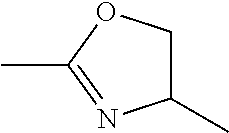Tetrahydrobenzoisoxazole and tetrahydroindazole derivatives as modulators of the mitotic motor protein
- Summary
- Abstract
- Description
- Claims
- Application Information
AI Technical Summary
Benefits of technology
Problems solved by technology
Method used
Image
Examples
example 2
Synthesis of N-[2-(2-dimethylaminoethylcarbamoyl)-1-(3-hydroxyphenyl)ethyl]-4,5,6,7-tetrahydrobenzo[d]isoxazole-3-carboxamide
[0135]
b. Compound 4 was obtained analogously to procedure a. from the acid 1 and methyl 3-amino-3-(3-hydroxyphenyl)propionate. Compound 4 (40 mg, 0.12 mmol) and N,N-dimethylethylenediamine (0.5 ml) were stirred at 100° C. for 12 h in a pressure flask. Ethyl acetate was added to the cooled solution, the mixture was washed with water, dried, filtered and evaporated to dryness. The residue was recrystallised from EtOH / water, giving a colourless solid, which was identified as compound 5.
example 3
Synthesis of N-((1S,2S)-2-methylaminoindan-1-yl)-4,5,6,7-tetrahydrobenzo-[d]isoxazole-3-carboxamide
[0136]
c. Compound 6 was obtained analogously to procedure a. from the acid 1 and cis-1-amino-2-indanol.
[0137]Compound 6 (158 mg, 0.53 mmol) was initially introduced in dichloromethane (5 ml), triethylamine (0.06 ml, 0.80 mmol) was added, and methanesulfonyl chloride (0.15 ml, 10.06 mmol, dissolved in 1 ml of DCM) was added dropwise at 0° C. The mixture was subsequently stirred at RT for 12 h. The mixture was evaporated to dryness, the residue was taken up in ethyl acetate and washed with water. The org. phase was dried, filtered and evaporated to dryness. The residue (about 140 mg of crude substance) was employed in the next reaction without further purification.
[0138]Half of the crude substance (70 mg) was taken up in methylamine (33% solution in EtOH, 1 ml) and stirred at 100° C. for 8 h in a pressure flask. The solution was evaporated to dryness and purified directly by column chrom...
example 4
Synthesis of 3-(4-phenyl-4,5-dihydrooxazol-2-yl)-4,5,6,7-tetrahydrobenzo[d]-isoxazole
[0139]
d. Compound 8 was obtained analogously to procedure a. from the acid 1 and 2-phenylglycinol.
[0140]Compound 8 (106 mg, 0.37 mmol) was dissolved in dichloromethane (5 ml), thionyl chloride (0.06 ml, 0.89 mmol) was added, and the mixture was stirred at 70° C. for 2 h in a pressure flask. The batch was allowed to cool, and sat. NaHCO3 solution was added to the mixture. The org. phase was separated off, dried over Na2SO4, filtered and evaporated to dryness. This residue was dissolved in MeOH (5 ml), NaOH (about 15 mg, 0.37 mmol) was added, and the mixture was left to stir at 70° C. for a further 2 h in a pressure flask. The batch was allowed to cool and was evaporated to dryness. The residue was taken up in DCM (5 ml) and extracted twice with sat. NaHCO3 solution. The org. phase was dried over Na2SO4, filtered and evaporated to dryness. The product was subsequently crystallised from ethyl acetate / c...
PUM
| Property | Measurement | Unit |
|---|---|---|
| Time | aaaaa | aaaaa |
| Ratio | aaaaa | aaaaa |
Abstract
Description
Claims
Application Information
 Login to View More
Login to View More - R&D
- Intellectual Property
- Life Sciences
- Materials
- Tech Scout
- Unparalleled Data Quality
- Higher Quality Content
- 60% Fewer Hallucinations
Browse by: Latest US Patents, China's latest patents, Technical Efficacy Thesaurus, Application Domain, Technology Topic, Popular Technical Reports.
© 2025 PatSnap. All rights reserved.Legal|Privacy policy|Modern Slavery Act Transparency Statement|Sitemap|About US| Contact US: help@patsnap.com



